|
Wicker's Enduring Charm
by
Bob Brooke
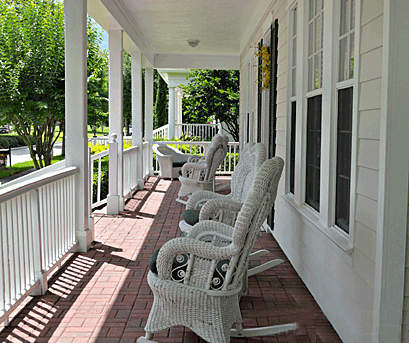 It’s
1895, and as you approach the wide, sweeping porch of a late Victorian
country home you notice several striking, white wicker armchairs. As you
enter the home, you see a wicker and hickory chair sitting in the
parlor. It’s
1895, and as you approach the wide, sweeping porch of a late Victorian
country home you notice several striking, white wicker armchairs. As you
enter the home, you see a wicker and hickory chair sitting in the
parlor.
Wicker has a long and interesting history, beginning in ancient Egypt.
The Egyptians wove the first wicker from palms, willows, rush and other
materials, into simple boxes, baskets and stools. Although all classes
of people owned wicker, it was only the important Egyptians with enough
wealth to afford spacious tombs, who had it buried with them to use in
their afterlife.
Early Wicker
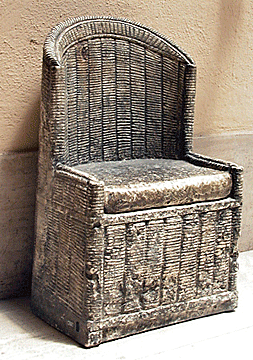 The
Romans also used wicker. It played a role in nearly every function of
the empire, from taking part in the cultural gatherings of great rninds
to assisting with the day-to-day activities of individual households.
Until Roman times, the usual wicker pieces had been boxes, baskets, and
stools, but by then wicker furnishings included chests, flexible chairs,
divans and reclining chairs. The
Romans also used wicker. It played a role in nearly every function of
the empire, from taking part in the cultural gatherings of great rninds
to assisting with the day-to-day activities of individual households.
Until Roman times, the usual wicker pieces had been boxes, baskets, and
stools, but by then wicker furnishings included chests, flexible chairs,
divans and reclining chairs.
While the art of making larger, more complicated pieces eventually
disappeared from Rome, wicker continued to be made in England and
Europe.
Meanwhile, the Chinese began fashioning loosely woven peacock and
fan-back chairs out of wicker. Europeon traders
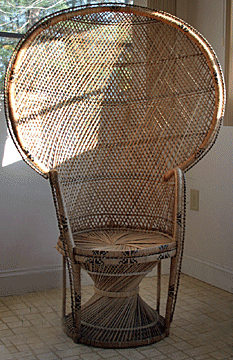 noticed
them and brought many of these chairs back to their home ports aboard
clipper ships. These exotic chairs added a hint of the mysterious Orient
to gardens already furnished with locally made wooden and wicker seats. noticed
them and brought many of these chairs back to their home ports aboard
clipper ships. These exotic chairs added a hint of the mysterious Orient
to gardens already furnished with locally made wooden and wicker seats.
These same ships carried ballast of rattan to keep their cargo from
moving while on the open seas. Once the ships were in home port, in
order to gain access to the merchandise in the holds, the crews had to
empty the rattan onto the docks, where they just left it. And there it
stayed until someone disposed of it. One of the men who usually helped
clear the Boston docks in 1844 was a grocer named Cyrus Wakefield.
Cyrus Wakefield
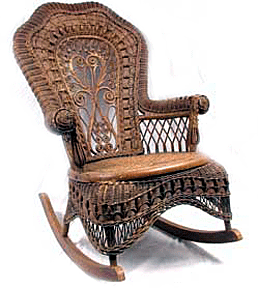 Wakefield
decided to recycle the rattan by using it to make furniture. He went on
to create a more ornate style of wicker that was so popular he founded
the Wakefield Rattan Company in South Reading, Massachusetts, in 1855.
Later the grateful citizens of the community honored him by renaming
their town Wakefield. Wakefield
decided to recycle the rattan by using it to make furniture. He went on
to create a more ornate style of wicker that was so popular he founded
the Wakefield Rattan Company in South Reading, Massachusetts, in 1855.
Later the grateful citizens of the community honored him by renaming
their town Wakefield.
Wakefield first used the pliable, shiny rattan to wrap around wooden
chairs to make outdoor furniture. Then he began to split the outer bark
of the rattan into strips called cane, to weave into seats and backs for
indoor chairs and settees. Finally, he discovered that the porous
substance under the cane could be made into reed to weave wicker with a
more absorbent surface than rattan that would take paint and stain.
But Wakefield wasn’t the only person to realize wicker’s potential. Both
J & C Berrian and Topf of New York City were in production by the late
1850s, using wooden frames wrapped with cane and ornamented reed.
As the1850s ended, Wakefield and others gradually switched from rattan
to reed because reed tuned out to. be more flexible in forming and more
receptive to paints in decorating.
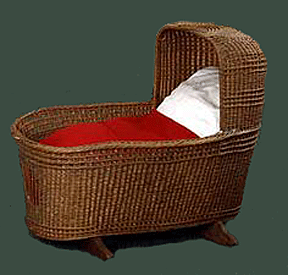 As
production advanced, wicker furniture manufacturers wrapped flat reed
with strands of cane were made of that reed which were wrapped with
strands of cane. They used round reed for the back and arms of both
chairs and settees, intricately weaving it to form links, circles, and
scrolls. As
production advanced, wicker furniture manufacturers wrapped flat reed
with strands of cane were made of that reed which were wrapped with
strands of cane. They used round reed for the back and arms of both
chairs and settees, intricately weaving it to form links, circles, and
scrolls.
Wicker was hardly new to the 19th century, It had been native to
American Indians when the Pilgrims landed, bearing their own wicker
baskets and infant cradles.
Over the years Heywood Brothers Company of Gardner, Massachusetts, gave
Wakefield strong competition, helping to satisfy the growing market for
wicker furniture. After the two companies joined forces in 1897, they
began to outsell all the other wicker manufacturers.
America’s Romance With Wicker
Comfortable, flexible, informal, masculine or feminine styles, wicker
adapted itself to any situation or location. Not only did it feel right
in gardens and on porches, by the 1860s, it had found its way into
homes.
America's romance with wicker furniture had reached its peak in the
1880's when American manufacturers began to use new machinery to weave
and shape rattan, bamboo, willow, and other materials that would come to
be called wicker.
Wicker Designs and Ornamentation
While the British were still making wicker chairs with functional,
skirted styles, woven the same tight way as baskets from about 1850
through the 1890s, American manufacturers had been producing ornately
styled wicker made up of open-work patterns. Until then, wicker had been
left in its natural color or lightly stained. But by the 1890s, painted
wicker had become popular.
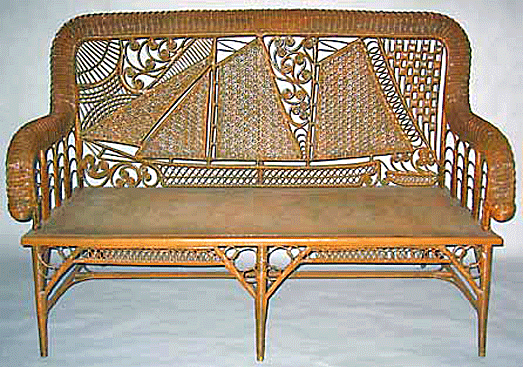
Wicker for the home was elaborate, trimmed with as many curlicues,
scroll work, beadwork, shell designs, rosettes, garlands and loops as
possible. Homeowners could purchase not only accent chairs but sets in
matching designs—one or two chairs and a settee, a chair and rocker, or
two side chairs and a center table. Furniture retailers also offered
accessory pieces like sewing baskets on long decorated legs, baby
carriages, cradles and high chairs, music stands, whatnots, and waste
baskets.
The incredibly ornate decorations can be identified loosely under
artistic classifications such as shell, motif, heart-shaped, or
open-weave back panels for chairs, settees and rockers, stick-and-ball
styles, classic serpentine for chair backs and rolled for chair arms and
backs. The fancier the decorations, the more the Victorians seemed to
like the wicker, and manufacturers adapted each other's styles with
flair and imagination.
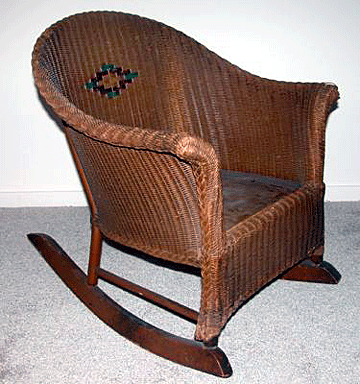 Gradually,
Victorian fussiness gave way to the clean lines of the Arts and Crafts
style as the 20th century dawned. Definitely not a light feminine look,
this style utilized a tightly pulled, over and under weave, creating
solid panels on backs, arms and aprons. For a few years several
companies made the transition between the two styles by applying scrolls
to the edges of smooth, tightly woven pieces. Consumers soon required
upholstered seats and backs on their wicker chairs because when wicker
dried out, it tended to catch on clothing. This forced manufacturers to
raise prices for their pieces. Gradually,
Victorian fussiness gave way to the clean lines of the Arts and Crafts
style as the 20th century dawned. Definitely not a light feminine look,
this style utilized a tightly pulled, over and under weave, creating
solid panels on backs, arms and aprons. For a few years several
companies made the transition between the two styles by applying scrolls
to the edges of smooth, tightly woven pieces. Consumers soon required
upholstered seats and backs on their wicker chairs because when wicker
dried out, it tended to catch on clothing. This forced manufacturers to
raise prices for their pieces.
The answer was to return to the open weave, but to continue with the
plain, over and under pattern instead of elaborate Victorian fancywork.
Designers then rounded the angles and gently curved various straight
lines, resulting in a style called Bar Harbor. Resorts like the Hotel
del Coronado in San Diego ordered them by the dozens and set them on
their verandas.
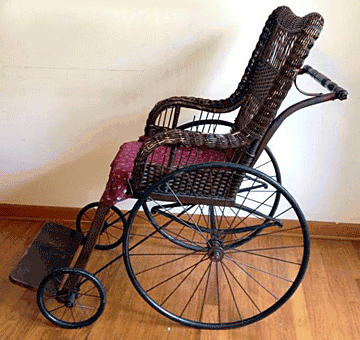 Keeping
up with the continuing trend, theaters like the Casino and Broadway in
New York City decorated their box seating sections in white wicker. Even
the various modes of transportation softened the ride with wicker.
Luxurious steamships, including the Queen Mary, and the smaller but no
less luxurious yachts coaxed their passengers to relax in cushioned
wicker. For many years trains pulled private cars and club cars
outfitted with wicker. Keeping
up with the continuing trend, theaters like the Casino and Broadway in
New York City decorated their box seating sections in white wicker. Even
the various modes of transportation softened the ride with wicker.
Luxurious steamships, including the Queen Mary, and the smaller but no
less luxurious yachts coaxed their passengers to relax in cushioned
wicker. For many years trains pulled private cars and club cars
outfitted with wicker.
In 1917, a Michigan man, Marshall Lloyd, developed and patented his
Lloyd Loom that wove flat sheets of wicker. As costs kept rising,
manufacturers began to lean toward the machine-woven wicker and
experimented with an artificial reed called fiber, a combination that
produced cheap, quick wicker furniture. This allowed the expensive,
tightly woven, over and under patterns to be made economically and
quickly, which were then easily fastened onto wooden furniture frames.
The sheets were ideal for the Art Deco designs that were all the rage in
the 1920s, creating wicker radios, lamps and case furniture as well as
the usual chairs and settees.
As the Great Depression dawned at the end of the 1920s, wicker went out
of style. But years later, it came back into fashion and today is as
popular as when Victorians sat on it on wide porches in the summer.
<
Back to Antiques Archives
Next Article > |
